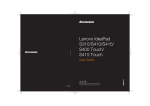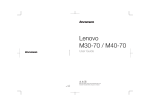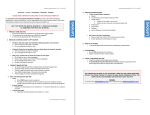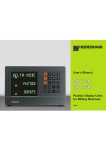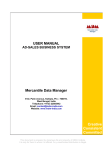Download User Guide - Newegg.com
Transcript
, Read the safety notices and important tips in the included manuals before using your computer. Notes Before using the product, be sure to read Lenovo Safety and General Information Guide first. Some instructions in this guide may assume that you are using the Android system. If you are using another operating system, some operations may be different. The features described in this guide are common to most models. Some features may not be available on your computer or your computer may include features that are not described in this user guide. The illustrations in this manual may differ from the actual product. Please refer to the actual product. Regulatory Notice The Regulatory Notice provides information about the radio frequency and safety standards. Be sure to read it before using wireless devices on your computer. To refer to it, go to http://support.lenovo.com, click SUPPORT, and then click GUIDES & MANUALS. First Edition (July 2013) © Copyright Lenovo 2013. Chapter 1 Getting to know your computer Chapter 2 Starting to use your compuer Chapter 3 Troubleshooting Trademarks C H AP T E R 1 Top view Note: The dashed areas indicate parts that are not visible externally. Attention: When closing the display panel, be careful not to leave pens or any other objects in between the display panel and the keyboard. Otherwise, the display panel may be damaged. 1 2 Integrated camera (on select models) Wireless LAN antennas Use the camera for the video communication. Connect to the wireless adapter to receive and send wireless radio. 3 Multi-touch screen 4 5 Caps lock indicator Functions as the visual display as well as one of the two primary input methods. For details, see Gestures. ON: All typed letters are uppercase by default. Touch pad The touch pad functions as a conventional mouse. Touch pad: To move the pointer on the screen, slide your fingertip over the pad in the direction in which you want the pointer to move. Touch pad buttons: The functions of the left/right side correspond to those of the left/right mouse button on a conventional mouse. Note: You can enable/disable the touch pad by pressing . Keyboard hotkeys You can access certain system settings quickly by pressing the appropriate hotkey. Goes back to the previous screen. Opens the home screen (similar to the Home icon). Opens the Apps screen (similar to the Apps launcher icon). Locks the screen. Enables/disables the touch pad. Opens the settings screen. Forces to be the landscape mode. Mutes/unmutes the sound. Opens the browser screen. Decreases the volume level. Takes a snapshot of the current screen. Increases the volume level. Opens the search screen. Decreases the display brightness. Increases the display brightness. Positioning the display panel The display panel can be opened up to 300 degrees. Notebook Mode Enables/disables Airplane mode. Toggles the screen between different apps. Opens a shortcut menu. Suitable for tasks that require a keyboard and mouse (such as creating documents, writing emails, and so on). Stand Mode (Theater Mode) Suitable for tasks that require little or no touch (such as viewing photos or playing videos). Attention: Do not open the display with too much force, otherwise the panel or hinges may be damaged. Note: The keyboard and touch pad are automatically locked if the keyboard panel faces down. Left-side view 1 2 3 Power button Press this button to turn on the computer. USB port Combo audio jack Connects to USB devices. For details, see Connecting USB devices. Connects to headsets. Notes: The combo audio jack does not support conventional microphones. The recording function may not be supported if third-party headphones or headsets are connected, due to different industry standards. Connecting USB devices Your computer comes with two USB ports compatible with USB devices. To set up the connection, plug the USB connector of the USB device into the USB port on your computer. Before disconnecting a USB storage device, make sure your computer has finished transferring data to that device, otherewise the data may be damaged. Then perform the following steps: 1 Select → Settings → Storage. 2 Select Remove Storage Device. 3 Select OK to remove it. Disconnect the device after it is safely removed. Note: If your USB device uses a power cord, connect the device to a power source before connecting it. Otherwise, the device may not be recognized. Right-side view 1 2 3 USB port Connects to USB devices. Memory card slot Micro USB port Insert memory cards (not supplied) here. For details, see Using memory cards (not supplied). Connects the USB cable of the AC power adapter, to charge the computer battery or transfer data. 4 System status indicators Indicator Indicator status Charge status Charging Meaning The battery’s charge is less than 10%. On (orange) Low battery On (blue) Battery status indicator Charging Blinking every 2s (orange) Blinking every 2s (blue) The battery’s charge is more than 10%. / New unread messages to be handled. / New unread messages to be handled. Unplugging of charging Off The battery needs to be charged. cable The computer is off or the battery electricity is more than 10%. Note: When disconnected from the AC power adapter, a prompt appears on the screen to warn you if the battery's charge reaches low and critical power levels. 5 6 Micro HDMI port Built-in microphones Connects to devices with HDMI input such as a TV or an external display. Capture sound which can be used for video conferencing, voice narration, or audio recording. Using memory cards (not supplied) Your computer supports the micro-SD cards (up to 64 GB). Inserting a memory card 1 Align the memory card with the memory card slot. 2 Slide the memory card in until it clicks into place. Removing a memory card 1 Push the memory card in until you hear a click. 2 Gently pull the memory card out of the memory card slot. Bottom view 1 Reset hole Resets your computer. 2 3 SIM card slot (on select models) Speaker Using SIM cards (not supplied) Insert a SIM Provides audio card output. (not supplied) here. For details, see Using SIM cards (not supplied). Your computer supports standard SIM cards. Inserting a SIM card 1 Align the SIM card with the SIM card slot. 2 Slide the SIM card in until it clicks into place. Removing a SIM card 1 Push the SIM card in until you hear a click. 2 Gently pull the SIM card out of the SIM card slot. Note: Some SIM cards may not be supported. For details, consult the local service provider. C H AP T E R 2 First use Reading instructions Read the instruction manuals before operating your computer. Connecting to a power supply 1 Connect the USB cable to the AC power adapter. 2 Securely connect the USB cable to the Micro USB port on the right side of the computer. 3 Insert the power plug of the AC power adapter into a power socket. Starting the computer Press and hold the Power button for five seconds or more. The Lenovo logo and startup screen appear. Shutting down the computer To shut down the computer, do one of the following: In the status drop-down list, select Shut Down → OK. Press and hold the Power button for five seconds or more and select Shut Down. Note: If the system does not respond or you cannot shut it down, use the reset hole to reset your computer. Graphical user interface The graphical user interface (GUI) changes interactively, such as the home screen or Apps screen. Note: Screenshots are only for reference and may differ from your screen. Home screen 1 Status bar: displays information about wireless connection, power supply, battery state, and clock. 2 Apps launcher: launches the Apps screen. 3 Custom app icons: displays custom app icons. 4 Show/hide app icons: shows or hides the app icons on the task bar. Apps screen 1 Home: accesses the home screen. 2 Back: returns to the previous screen. Status drop-down list The status drop-down list contains the following frequently used functions. Enable or disable Wi-Fi, Bluetooth, airplane mode, or screen rotation. Increase or decrease volume and brightness. Restart the computer, put it to sleep, or shut it down. To open this list, use the touch pad or gesture to drag the status bar in the upper right corner of the screen downwards. Gestures Gestures allow you to interact with the apps by manipulating the screen objects. The following table shows the core gesture set. Touch Press, lift Triggers the default functionality for a given item. Long press Press, wait, lift Allows you to select one or more items in a view and act upon the data. Swipe Press, move, lift Scrolls over flowing content, or navigates between views in the same hierarchy. Drag Long press, move, lift Rearranges data within a view, or moves data into a container. Double touch Two touches in quick succession Zooms into content. Also used as a secondary gesture for text selection. Pinch 2-finger press, move outwards/inwards, lift Zooms into or out of content. Connecting to wireless LAN Your computer comes with a wireless network card. It enables you access Internet via a wireless network. Enable Wi-Fi To enable the Wi-Fi function, select → Settings → Wi-Fi, and then toggle the Wi-Fi switch to ON. After wireless has been enabled, the computer will automatically scan for available wireless networks and display them in the wireless LAN network list. You can select any network in the list. After selecting a network, click Connect. You can also select → Advanced to make the advanced Wi-Fi settings. You can also manually scan or add a network. Note: Each Wi-Fi network name has a status icon followed. indicates the access password is not required and you can directly connect it. indicates the network is encrypted and you can only successfully connect it after a proper password is input. Disable Wi-Fi To disable the Wi-Fi function, do one of the following: Select → Settings → Wi-Fi and toggle the Wi-Fi switch to OFF. Select → Settings → More and check the Airplane mode option. Note: All wireless connections on the computer will be disabled as soon as the airplane mode is enabled. C H AP T E R 3 Frequently asked questions This section lists frequently asked questions by category. Finding information What safety precautions should I follow when using my computer? The Lenovo Safety and General Information Guide which came with your computer contains safety precautions for using your computer. Read and follow all the precautions when using your computer. Where can I find the hardware specifications for my computer? You can find hardware specification for your computer on the printed flyers which came with your computer. Where can I find warranty information? For the warranty applicable to your computer, including the warranty period and type of warranty service, see the Lenovo limited warranty flyer that came with your computer. Getting help How can I contact the customer support center? See “Chapter 3. Getting help and service” in the Lenovo Safety and General Information Guide. Troubleshooting If you do not find your problem here, see Chapter 1. Display problems When I turn on the computer, nothing appears on the screen. If the screen is blank, make sure that: - The USB cable is connected to the computer, and the AC power adapter is plugged into a working electrical outlet. - The computer power is on. (Press the Power button again for confirmation.) If these items are properly set, and the screen remains blank, have the computer serviced. The screen goes blank while the computer is on. Do one of the following to resume from sleep mode: - Press any key on the keyboard. (Notebook mode only) - Press the Power button. Sleep problems The critical low-battery error message appears, The battery power is getting low. Connect the USB cable and the AC power adapter to the computer. and the computer immediately turns off. The computer enters sleep mode immediately after power-on. Make sure that: - The battery is charged. - The operating temperature is within the acceptable range. See “Chapter 2. Use and care information” in the Lenovo Safety and General Information Guide. Note: If the battery is charged and the temperature is within range, have the computer serviced. The computer does not return from sleep mode and the computer does not work. If your computer is in sleep mode, connect the USB cable and the AC power adapter to the computer, then press the Power button. If your computer is powered-off, connect the USB cable and the AC power adapter to the computer, then press the Power button to resume operation. Note: If the system still does not return from sleep mode, your system has stopped responding, and you cannot turn off the computer; reset the computer. Unsaved data may be lost. Use the reset hole to reset the computer. Display panel problems The screen is blank. Do the following: - If you are using the AC power adapter or the battery, and the battery status indicator is on, press make the screen brighter. - If the computer is in sleep mode, press any key to wake it up. Incorrect characters appear on the screen. Are the operating system or programs installed correctly? If they are installed and configured correctly, have the computer serviced. Sound problems No sound can be heard from the speaker even when the volume is turned up. Make sure that: - The Mute function is off. - The combo audio jack is not being used. - Speakers are selected as the playback device. Battery problems Your computer shuts down before the battery status indicator shows empty. Recharge the battery. - or Your computer operates after the battery status indicator shows empty. Other problems Your computer does not respond. Press and hold the Power button for five seconds or more and select Shut Down to turn off your computer. If the computer still does not respond, use the reset hole to reset your computer. The connected external device does not work. Do not connect or disconnect any external device cables other than USB while the computer power is on. Otherwise, you might damage your computer. The following terms are trademarks or registered trademarks of Lenovo in the United States, other countries, or both. Lenovo IdeaPad Android en-US Rev.AA00















